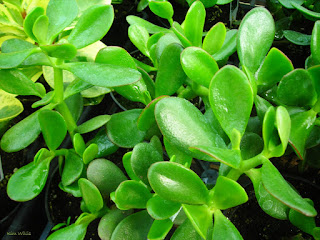 |
| Young Jade plant |
Jade plants, (Crassula ovata), also called Dollar plants,
are in the stonecrop family, which has many hardy species. Jade plants which are native to South Africa,
are usually kept as houseplants and can live in your home for dozens of years
if they are well cared for. In plant
hardiness zones 10 and above they can be planted outside.
Jade plants are readily available on the market and are a
fairly easy houseplant to grow. There are some closely related species of
crassula that can also be purchased from greenhouses on occasion and these are
cared for in a similar manner.
Jade plants are succulents with thick, shiny, rounded
dark green leaves arranged opposite each other on thick stems which, with age,
become woody looking. In many Jade
plants the leaves are edged in red. In
the variety ‘Hummels Sunset’ the leaves are orange and yellow with a touch of
red. In the variety ‘Tricolor’ the
leaves are marked with cream and pink.
In the right conditions Jade plants will bloom in late
winter- early spring. The blooms are
clusters of tiny, star shaped pinkish flowers with a darker center.
In the home Jade plants can grow to 3’ tall and
wide. In a greenhouse or heated sunroom
they may grow even larger. There are
some cultivars that don’t develop a strong stem and tend to sprawl or
weep.
Jade plant care
As a succulent Jade plants need to be planted in a well-drained
planting medium. Use a cactus mix or mix
1 part clean sand with 2 parts of a good houseplant “soil”. All pots must have good drainage.
Jade plants tend to have shallow root systems and often
become top heavy. The plant may need to be staked so that it
doesn’t topple and pull itself out of the pot.
Heavy clay pots may help anchor the Jade plant and keep the pot from
tipping over. If the plant does topple over simply replace it in the pot and
firm the soil back around the roots. You
can also prune the Jade plant with pruning shears to help balance the plant.
The leaves and stems of Jade plants are brittle and break
easily. They need to be placed in
locations where they don’t get bumped or handled often. Also make sure the Jade plant is not in a
draft or directly above heating or air conditioning vents.
Jade plants prefer full sun such as a south or west
window indoors but do fairly well in bright indirect light. They can be moved outside after all danger of
frost has passed but place them in the shade first and gradually move them into
full sun. Turn the pot every time you
water so the plant doesn’t lean toward the light.
Let the Jade plant dry out between watering, but don’t
let the leaves shrivel. When you water,
add water until it drains from the pot bottom.
Be sure to empty saucers under the plants after watering. Over watered Jade plants will shrivel just
like a dry Jade as the root system rots so make sure to feel the surface before
watering. In the winter Jade plants will
need less water. Outside in the summer
make sure to check frequently so that the plants don’t get too dry.
To promote blooming fertilize with a houseplant
fertilizer in late winter. Jade plants
are more likely to bloom when they are in full sun conditions. Gently wipe the leaves of Jade plants from
time to time to remove dust.
Propagating Jade plants
Jade plants are usually started from cuttings and the
plant will look just like its parent.
Jades are easy to start from cuttings and a single leaf can start a new
plant. If leaves break off the plant or
you need to prune it to keep it from toppling over, the removed pieces can be
used to start new plants.
Remove a side stem with two or more sets of leaves just
below the second leaf section to propagate by cutting. Or remove a single leaf to start a new
plant. Use small pots filled with
moistened cactus mixture or vermiculite.
Make a small indentation in the soil mix and either insert the base of a
leaf or remove the lower set of leaves from your stem cutting and insert the
stem in the potting medium to just below the old leaf site (node). Firm the soil around the cutting.
Do not enclose the cutting in plastic or glass. Let the soil dry slightly between
watering. When you see new leaves on the
Jade plant it means it has rooted. You
can share the plant with a friend or fill another window spot.
A Jade plant is a beautiful addition to the home or
office. It is a good looking houseplant
that doesn’t take much care. And like
all houseplants it adds oxygen to the room and helps clean the air. All rooms deserve houseplants.
Do you have fruit trees you have planted in the last ten years that are misshapen, and you haven't pruned them because you didn't know what to do? In 45 seconds, Sam shows you how to prune them correctly and keep them on the right track online at Raintree Nursery - one of the best mail order nursery.
ReplyDelete